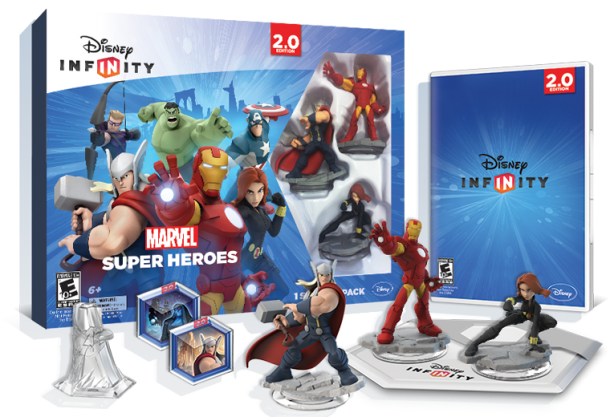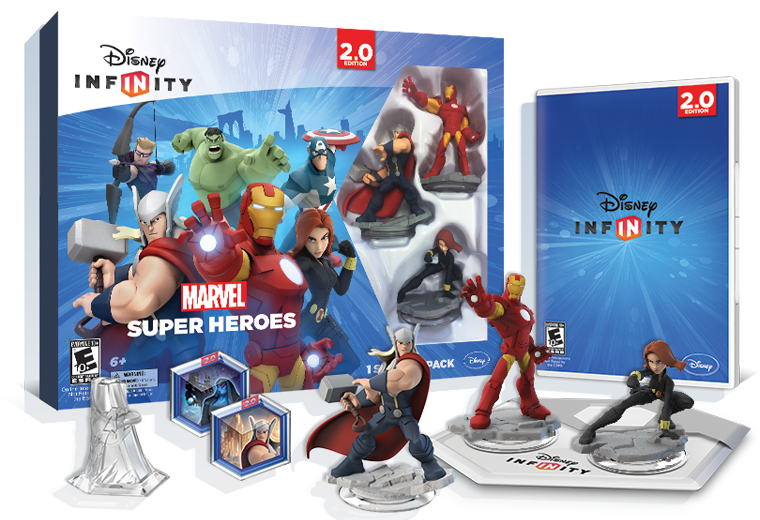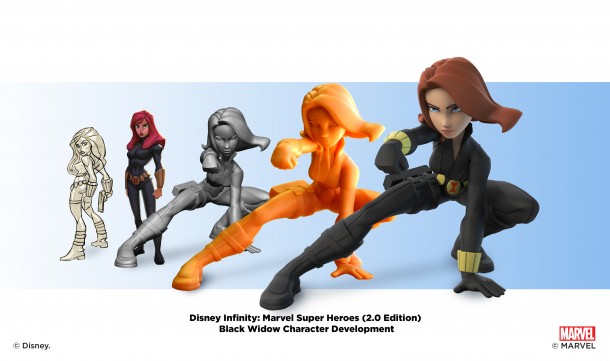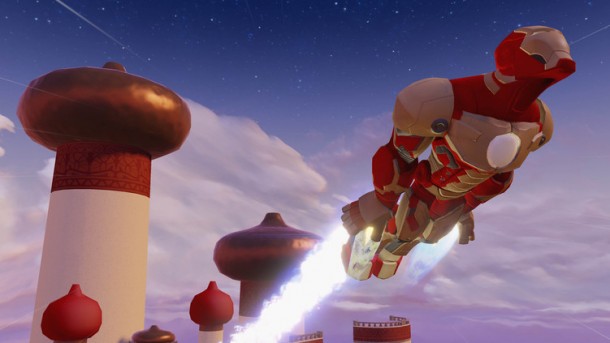Since the announcement of the first Disney Infinity, there has been speculation that Marvel characters would eventually find their way onto the platform. With the release of Disney Infinity 2.0, Disney has seen fit to focus on some of Marvel’s famous names. Disney Infinity: Marvel Super Heroes (2.0 Edition) Starter Pack packages together the 2.0 software, Marvel’s The Avengers Play Set piece, two Toy Box Game Discs, three Super Heroes Figures: Thor, Iron Man and Black Widow, the USB Infinity Base and a web download code to unlock content in the free PC version of the game. It certainly is packed with content and plenty of things to do, but the interplay between all of it and its reliance on repetitive actions may be its greatest downfall.
(The following review is written under the assumption that this is the reader’s first time with the Disney Infinity series or any toy/game combo, as it was for the reviewer)
The Toys
Disney Infinity’s figures are visually stunning. Designed to look exactly how they do in the game, the paints and materials used in their construction match exactly to the game’s visual quality. It’s actually quite an amazing experience to see the toy you just had in your hand appear on screen to the same quality of detail. The toys are in permanent poses, but they definitely have a bit of give to them because of the material they’re constructed out of. It feels like a slightly malleable plastic or a harder rubber.
The toys are sturdy, but with enough effort some of the limbs or thinner pieces of each character could be torn off, like Thor’s cape or Black Widows arms. It should also be noted that if one of these toys were to end up in the mouth of a child or animal it will definitely bear the marks for life. Regardless of damage the toys should still operate in the game, since the important functions of each are stored in their bases.
The Toy Box games and Avengers Play Set piece are all made of a hard plastic, so chances are those won’t receive any damage. The Disney Infinity Base is also made of hard plastic, but accidentally stepping on it the right way might spell disaster for its use.
Marvel’s The Avengers Play Set and the Toy Box Games
Following an original story based off the Avengers movie, the play set finds the Avengers trying to track down and capture Loki after he has started to freeze over New York City in an attempt to take it over with frost giants. The plot is basically an afterthought and more of an excuse to put the Avengers to work in an open world roughly based on NYC. The environment is expansive and filled with content, but it’s just a shame that most of that content is repetitive and boring.
Gameplay boils down to an action beat ‘em up that has little depth in its fighting system. Characters are limited to just one melee attack button, a ranged secondary attack and a dodge. Each character can expand their attacks by defeating enemies and leveling up, awarding points to spend on upgrades in a skill tree. Upgrades include things like increased damage and health while also offering a few attack modifiers and special moves. Characters can also get a decent wave clear ability, but regardless of the upgrade it doesn’t meaningfully impact the gameplay of each character.
Missions consist of fighting enemies, running to a place and protecting something from enemies, following enemies to specific locations to fight them or delivering something while fighting enemies. Save for a few driving missions that also sometimes have you fighting enemies, missions are repetitive with usually just a different dialogue before they begin. Since there is almost no depth in the combat, this leaves players just mashing the attack button until everything on screen is dead. Players will get to explore the city looking for hidden collectibles and challenges, but none that dramatically alter the formula of the story missions or make up for the repetitive nature of everything else.

The two included Toy Box Game Discs, which are built using the game’s Toy Box mode, do little to change things up. One of them, “Assault on Asgard”, challenges players to protect an artifact from waves of enemies. Players are able to set up turrets and traps to help slow down enemies, but are still forced to yet again mash attacks in an effort to stop them. “Escape From the Kylan” also suffers from an over-reliance on combat, tasking players to defeat foes and look for an exit from a top down perspective with the help of a computer controlled buddy. Both games are mind-numbingly easy, especially if played with a leveled up character or cooperatively with a friend.
The Toy Box
Probably the biggest appeal to the Infinity series are the games’ Toy Box mode. Here players can build their own worlds and modes utilizing toys and utilities unlocked through playing the game in any mode. The sheer number of toys, representing everything from Disney Channel to Pixar properties, is staggering, ranging from set pieces to weapons or famous furniture. The game’s visual style helps keep these pieces grounded in the same aesthetic, even though some of the franchises are wildly different.
Disappointingly a majority of the game’s toys are locked in the toy store. These toys can be purchased with an in-game currency that is awarded through defeating enemies, finding blue toy capsules or completing missions. After completing the Avengers Play Set, a few rounds of the Toy Box Games and the Toy Box’s tutorial challenges, I was able to purchase a little over a third of the locked toys. Players can prioritize unlocking them any way they want, but it’s a little deflating when you remember seeing a locked toy that would fit perfectly in your build, but have to drop what you’re doing and go grind out enough currency to unlock it.
Building is certainly fun, and it’s nice to see an idea you had in your head become playable rather quickly. The building interface takes some getting used to, but thanks to sorting categories and a favorites list getting to the pieces you want becomes easier and easier. The game mode features a few computer driven builders you can place into the environment to build things for you, like a quick city or tree house. These can then be easily edited to your liking, making them a nice option to help fill empty space in a map.
The only real problem with building comes when precise placement is needed. There’s not a way to shift multiple pieces at a time, causing massive time wastes when trying to correct spacing between objects. Some pieces also have weird rules when it comes to placing objects next to them. Although an object looks like it has open space to place another object next to it, it might reject it for one reason or another. Reasons for rejection seem inconsistent, sometimes allowing one object but not another that shares the exact same properties.
These issues seem most prevalent in the Toy Box’s INterior mode. In this mode players construct a house, theming it and filling it with different Disney furniture sets and decorations. Players are given requests from townspeople walking around inside for specific rooms and decorations to be placed in both the house and a landscape. These challenges provide the most directed fun Disney Infinity 2.0 has to offer, forcing you to adapt designs around these requests, while also allowing for creativity. It’s just a shame that it’s easier to destroy large portions of a room rather than moving each individual piece in an attempt to line things up.
It becomes easier to ignore some of the more glaring issues the game has when playing it in co-op, though certain missions are almost comically easy. Being able to work side by side in the construction of an environment is a collaborative experience that not many other games have, and it’s nice that the entirety of the product allows for it.
Disney Infinity 2.0 has a lot to experience. These experiences rely on a player’s willingness to sit through the pedestrian to get a chance to participate in the creation of Disney magic. Some leeway on these issues could be given since this is a product aimed for a younger audience, but that’s really not an excuse for repetitive design and tool sets that don’t properly communicate their restrictions. The toys themselves look incredible and would be a great addition to any collection. For Disney fans there is plenty here to experience and keep you coming back, but for those looking for a dedicated adventure or construction game, there are plenty of other other titles that offer a better experience.
This review is based on a copy of the game for the Playstation 4 sent by the publisher to SideQuesting




No Comments